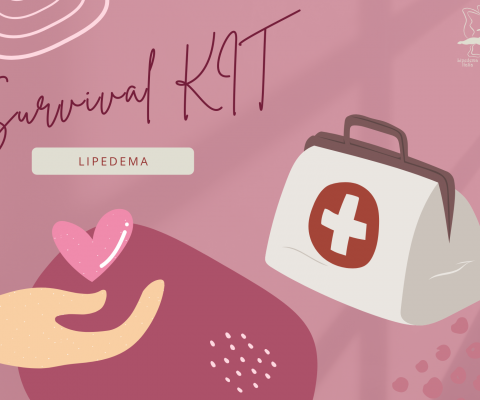Survival Kit

Ascolta i video contributi più recenti sul lipedema della Dr.ssa Karen Herbst, membro del Comitato Scientifico – Sezione Esperti internazionali.
La LIO Lipedema Italia Onlus esprime i suoi più sentiti ringraziamenti alla FAT DISORDERS RESOURCE SOCIETY come fonte di materiale prezioso e di valore sulla patologia del lipedema e invita a visitare il canale YouTube FDRS.
Playlist
Di tutta la letteratura open source disponibile su PubMed e altri portali specializzati, leggi almeno gli articoli più recenti sulla patologia.
Lipedema: A Painful Adipose Tissue Disorder
By Sara Al-Ghadban, Karen L. Herbst and Bruce A. Bunnell
Submitted: May 9th 2019
Reviewed: July 17th 2019
Published: August 20th 2019
DOI: 10.5772/intechopen.88632
Lipedema is a painful fat disease of loose connective tissue usually misdiagnosed as lifestyle-induced obesity that affects ~10% of women of European descent as well as other populations. Lipedema is characterized by symmetric enlargement of the buttocks, hips, and legs due to increased loose connective tissue; arms are also affected in 80% of patients. Lipedema loose connective tissue is characterized by hypertrophic adipocytes, inflammatory cells, and dilated leaky blood and lymphatic vessels. Altered fluid flux through the tissue causes accumulation of fluid, protein, and other constituents in the interstitium resulting in recruitment of inflammatory cells, which in turn stimulates fibrosis and results in difficulty in weight loss. Inflammation and excess interstitial substance may also activate nerve fibers instigating the painful lipedema fat tissue. More research is needed to characterize lipedema loose connective tissue structure in depth, as well as the form and function of blood and lymphatic vessels. Understanding the pathophysiology of the disease will allow healthcare providers to diagnose the disease and develop treatments.
Lipedema: A Call to Action!
Lipedema is a chronic progressive disease characterized by abnormal fat distribution resulting in disproportionate, painful limbs. It almost exclusively affects women, leading to considerable disability, daily functioning impairment, and psychosocial distress. Literature shows both scarce and conflicting data regarding its prevalence. Lipedema has been considered a rare entity by several authors, though it may be a far more frequent condition than thought. Despite the clinical impact on women’s health, lipedema is in fact mostly unknown, underdiagnosed, and too often misdiagnosed with other similarly presenting diseases. Polygenic susceptibility combined with hormonal, microvascular, and lymphatic disorders may be partly responsible for its development. Furthermore, consistent information on lipedema pathophysiology is still lacking, and an etiological treatment is not yet available. Weight loss measures exhibit minimal effect on the abnormal body fat distribution, resulting in eating disorders, increased obesity risk, depression, and other psychological complaints. Surgical techniques, such as liposuction and excisional lipectomy, represent therapeutic options in selected cases. This review aims to outline current evidence regarding lipedema epidemiology, pathophysiology, clinical presentation, differential diagnosis, and management. Increased awareness and a better understanding of its clinical presentation and pathophysiology are warranted to enable clinicians to diagnose and treat affected patients at an earlier stage.
Lipedema: Friend and Foe
Yanira Sanchez-De la Torre1, Rita Wadeea1,
Victoria Rosas2, Karen L Herbst1
- PMID: 29522416
- PMCID: PMC5935449
- DOI: 10.1515/hmbci-2017-0076
- Horm Mol Biol Clin Investig.2018 Mar 9;33(1):/j/hmbci.2018.33.issue-1/hmbci-2017-0076/hmbci-2017-0076.xml.
doi: 10.1515/hmbci-2017-0076.
Background Lipedema is a chronic disorder presenting in women during puberty or other times of hormonal change such as childbirth or menopause, characterized by symmetric enlargement of nodular, painful subcutaneous adipose tissue (fat) in the limbs, sparing the hands, feet and trunk. Healthcare providers underdiagnose or misdiagnose lipedema as obesity or lymphedema. Materials and methods The benefits (friend) and negative aspects (foe) of lipedema were collected from published literature, discussions with women with lipedema, and institutional review board approved evaluation of medical charts of 46 women with lipedema. Results Lipedema is a foe because lifestyle change does not reduce lipedema fat, the fat is painful, can become obese, causes gait and joint abnormalities, fatigue, lymphedema and psychosocial distress. Hypermobility associated with lipedema can exacerbate joint disease and aortic disease. In contrast, lipedema fat can be a friend as it is associated with relative reductions in obesity-related metabolic dysfunction. In new data collected, lipedema was associated with a low risk of diabetes (2%), dyslipidemia (11.7%) and hypertension (13%) despite an obese average body mass index (BMI) of 35.3 ± 1.7 kg/m2. Conclusion Lipedema is a painful psychologically distressing fat disorder, more foe than friend especially due to associated obesity and lymphedema. More controlled studies are needed to study the mechanisms and treatments for lipedema.
DISCLAIMER
Lio Lipedema Italia Onlus is grateful to all valuable websites and lipedema sufferers’ associations for all the precious materials
which are generously provided in their social channels to the benefit of all lipedema community worldwide.
Please consider visiting their websites for more info.
